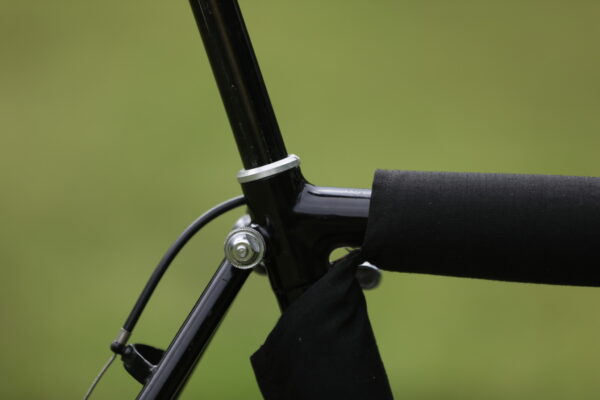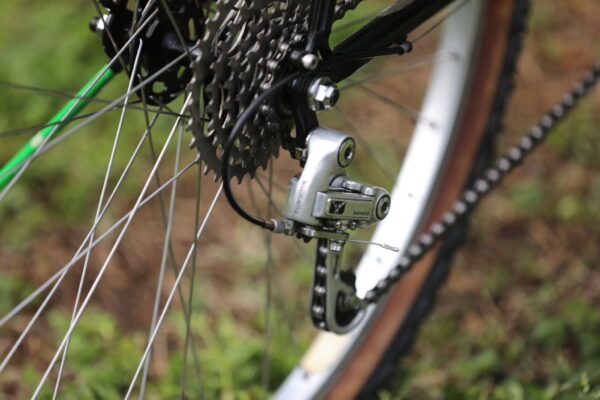While not “Numero Uno” this is the earliest known Fat Chance mountain bike at the time of this writing. The bike was built for a gentleman who upon visit a shop in New England in 1982 learned of Chris Chance and his bike and ordered one on the spot. Built in 1982 and delivered in early 1982 this is the 3rd mountain bike built by Chris Chance. I managed to obtain a secret and heavily redacted copy of the build log from 1982 which lists all of the 15 bikes built that year.

The majority of those first 15 bikes were built to order with barely a handful built to spec for bike shops to sell. I’ve only ever seen three of the 15 and they mostly seem to share the same common traits. Fillet brazed steel construction, matching fillet brazed box crown fork, integrated seat binder, road bike style front derailleur and added Aluminum sleeve to the seat tube to enable the use of BMX style Laprade seatpost. Later, maybe starting in 1983 Fat started offering matching fillet brazed Bullmoose bar/stem combos, but I do not think they were made in house.

The geometry on these early bikes is very slack, similar to contemporary designs coming from NorCal builders. Laid back seat tube and headtube angles combined with a raked out fork make for a comfortable ride. This basic design would continue largely unchanged into 1983 and 1984 ultimately getting dropped in 1985. Though you could order a fillet brazed bike in those later years they seemed to be few and far between making them some of the rarest Fat Chance bike in existence today.


Perhaps the most characteristic element of early Fats is the unique Box Crown fork. Finished in matching fillet brazing to complement the frame these early BC forks are among the prettiest forks ever to grace the front end of a mountain bike. Not renowned for their strength and durability they are also some of the rarest out there.

Though I much prefer bikes without rack mounts the sleek taper of the fork blades and very clean brazing around the dropouts really looks beautiful and accentuates the workmanship and attention to detail on this fork.


Another feature of the early generation of Fats is the integrated seat post binder into the top of the seat stays, similar to Ritcheys of the era. While certainly not unique to Fat Chance this design choice was only seen on the early bikes made by Chris and the team. Another distinguishing feature of early Fat including all 1982s is the Aluminum sleeve that supported the use of small diameter BMX seatposts made by Laprade. Apparently Ron Andrews of King Cage made all those sleeves for those early bikes.

According to Chris he hand brazed and finished all of the first 12 bikes himself making. I don’t know whether that holds true for all brazed bikes made in 83 and 84, but I would assume he made some of those as well.

Already present on the earliest bikes is the sealed bearing bottom bracket, but unlike the later bike which featured a cable guide mounted to the non drive side of the seat tube / BB shell junction these early bikes feature cable routing under the BB shell with small welded on cable guides.

The last distinguishing feature of most 1982 Fats is the braze on style front derailleur mount. Chris opted for this on his early bikes as it was a method he was used to on his road bikes, but given the limited selection of parts and the growing availability of mountain specific clamp on derailleurs abandoned in before the 83 run of bikes.



The build kit looks like it was taken off a 1983 Specialized Stumpjumper. By an. large it’s a M700 group in black with Tourney XT cranks, Tommaselli levers and grips, looks like a Specialized headset with a Suntour BMX locking top nut. I’ve considered swapping in black anodized M700 cranks to match the black build and may still do that as I plan to replace the Suntour stem and bars with a matching fillet brazed Bullmoose mar/stem I found on another Fat.


All in all this is a very well made bike that is in surprisingly well preserved condition givens its age. As I bought this from the original owner I had the chance to talk to him a lot about the bike and it seems that not long after buying the bike he moved from New England down to North Carolina and ended up getting back into road biking more and the Fat was relegated to city bike duty.
I’ve taken the bike on a few rides since rebuilding it and its quite pleasant to ride. Given the age of the tires I did not feel comfortable giving it any real sort of test, but plan to after making a few small changes like the Bullmoose bars, maybe swapping in M700 cranks and putting on some modern tires and taking it back out. The ride position is quite upright and comfortable and the handling is neither too sharp nor too slow, sort of fine. It’s not a bike that screams “go faster, go faster” or “luck up oversteer into the turn” but it also isn’t throwing. wet towel on your ride either. Most of the riding I’d do on a bike like this would be smoother single track or double track/fire road. I don’t think I’d enjoy myself nor would the bike shine on anything overly technical. Going fast felt stable and had it not been for the sketchy 40 year old tires I’d probably push it a bit faster. Stay tuned for a more formal ride review.
Completed Projects:
Current Projects:
Newsletter sign up:
Subscribe to our newsletter to receive info on our latest projects and new podcast releases
